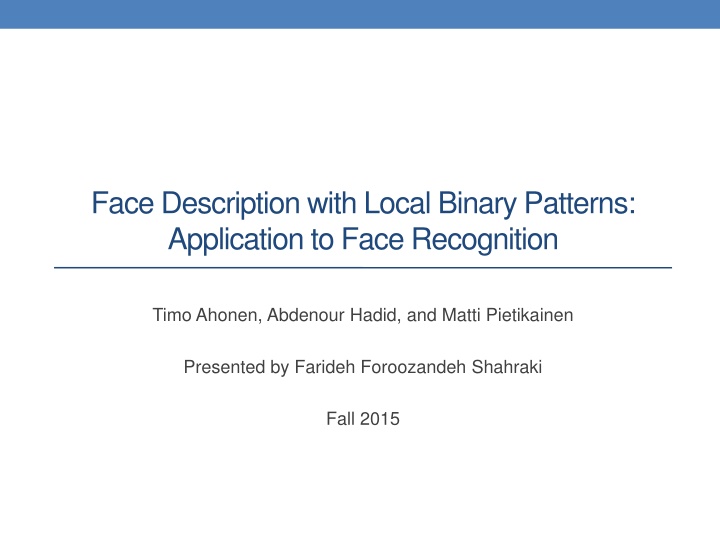
Local Binary Patterns for Face Recognition: A Detailed Overview
Explore the significance of Local Binary Patterns (LBP) in face recognition, including Uniform LBP, texture features, and pattern improvements. Understand how LBP descriptors enhance facial image analysis for improved identification accuracy and efficiency.
Download Presentation

Please find below an Image/Link to download the presentation.
The content on the website is provided AS IS for your information and personal use only. It may not be sold, licensed, or shared on other websites without obtaining consent from the author. If you encounter any issues during the download, it is possible that the publisher has removed the file from their server.
You are allowed to download the files provided on this website for personal or commercial use, subject to the condition that they are used lawfully. All files are the property of their respective owners.
The content on the website is provided AS IS for your information and personal use only. It may not be sold, licensed, or shared on other websites without obtaining consent from the author.
E N D
Presentation Transcript
Face Description with Local Binary Patterns: Application to Face Recognition Timo Ahonen, Abdenour Hadid, and Matti Pietikainen Presented by Farideh Foroozandeh Shahraki Fall 2015
2 Outline Part 1 Introduction LBP Uniform LBP Face Description using LBP Results Conclusion Part 2 Further improves of LBP (MLBP and staggered MLBP) References
3 Introduction Key issue is face analysis finding efficient descriptor for face appearance Holistic methods Principal component Analysis (PCA), Linear Discriminant Analysis (LDA), and 2D PCA Local region methods A facial image representation based on Local Binary Pattern (LBP) texture features from local facial regions. Strengths : Highly discriminative invariance to monotonic gray-level changes computationally efficient
4 LBP One the best performing texture descriptors A label is assigned to every pixel Use center pixel value to threshold the 3x3 neighborhood Result in binary number Histogram of the labels is used as a texture descriptor The Basic LBP operator
5 LBP (2) LBP is extended to use different sizes of neighborhoods. Local neighborhoods is defined as a set of sampling points. points evenly spaced on a circle centered at the labeled pixel. (P,R) , P = number of sampling points , R = radius Bilinear interpolation is used if sampling point is not in the center of the pixel. The circular (8,1), (16,2) and (8,2) neighborhoods. The pixel values are bilinearly interpolated whenever the sampling point is not in the center of a pixel.
6 Uniform LBP Uniform patterns to further improve LBP. Uniform patterns has at most 2 bitwise transitions in binary pattern. Histogram assigns separate bin for every uniform pattern. Histogram assigns a single bin for all non-uniform pattern. In FERET dataset, (8,1) neighborhoods : 90.6 percent of patterns are uniform.
7 Uniform LBP (2) Uniform patterns examples 00000000 (0 transitions) 01110000 (2 transitions) 11001111 (2 transitions) Non-uniform patterns examples 11001001 (4 transitions) 01010011 (5 transitions) 59 bins histogram Length of feature vector
8 Face description using LBP Step 1 : facial image is divided into local regions (blocks). {R0, R1, , Rm-1} (pixel-level locality) Step 2 : Extract LBP histogram for each region. (regional-level locality) Step 3 : Concatenated all histograms into a spatially enhanced histogram with length of m x n (n is length of a single LBP histogram). (global-level locality) Face description using LBP
9 Face description using LBP Specific facial features ( such as eyes) contain more important information Be weighted based on the importance of information Chi square distance is utilized x and = normalized enhanced histograms i= histogram index j= local region index wj= weight of region j (a) 7x7 windows (b) The weights set . Black squares indicate weight 0.0, dark gray 1.0, light gray 2.0 and white 4.0.
10 Dataset fa set, used as a gallery set, contains frontal images of 1196 people. fb set (1195 images). The subjects were asked for an alternative facial expression fc set (194 images). The photos were taken under different lighting conditions. dup I set (722 images). The photos were taken later in time. dup II set (234 images). This is a subset of the dup I set containing those images that were taken at least a year after the corresponding gallery image
11 Results Recognition Rate in Different Texture Descriptors For Local Facial Regions LBP is tolerance to monotonic gray-scale changes No gray-scale normalization is needed prior to apply Highly discriminative Computationally efficient
12 Results (2) The cumulative scores of the LBP and control algorithms on the (a) fb , (b) fc , (c) dupI and (d) dup II probe sets.
13 MLBP and Staggered MLBP Multi-Scale LBP (MLBP) More than one scale of neighborhoods Three scale with alternative radiuses of 1,3, and 5 more information 3*256 = 768-bin histogram Staggered MLBP 3*8=24 directions instead of 8 direction in traditional MLBP more feature information and a higher performance is expected.
14 MLBP and Staggered MLBP (2) Train 1300 positive and 1300 negative samples of bicycle with LBP, MLBP and staggered MLBP features Test 300 positive and 300 negative images ROC curves of LBP, MLBP and Staggered MLBP
15 Conclusion Facial images can be seen as micro-patterns(spots, edges, lines, etc.). This texture-based facial descriptor is based on dividing image into small regions. Computing a texture description of each region using LBP. Combined these descriptors into a spatially enhanced histogram or feature vector. Weighted Regions, better performance Pose invariant, illumination invariant, age invariant
16 References Ahonen, T., Hadid, A., Pietikainen, M.: Face Description with Local Binary Patterns: Application to Face Recognition. Pattern Analysis and Machine Intelligence, Vol.28, no.12 (2006) 2037-2041 Cao, Y., Pranata, S., Yasugi, M., Zhiheng, N., Nishimura, H.: Staggered Multi- scale LBP for Pedestrian Detection. In: 19th IEEE International Conference on Image Processing (ICIP 2012), 449-452 (2013) Http://www.scholarpedia.org/article/Local_Binary_Patterns
